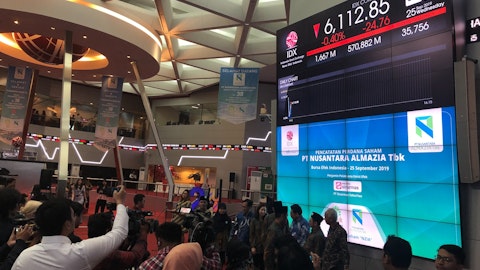Trinity Capital Inc. (NASDAQ:TRIN) Q4 2023 Earnings Call Transcript March 6, 2024
Trinity Capital Inc. misses on earnings expectations. Reported EPS is $0.54 EPS, expectations were $0.55. Trinity Capital Inc. isn’t one of the 30 most popular stocks among hedge funds at the end of the third quarter (see the details here).
Operator: Good afternoon. My name is Jami, and I will be your conference operator today. At this time, I would like to welcome everyone to Trinity Capital’s Fourth Quarter and Full-Year 2023 Earnings Conference Call. Our hosts for today’s call are Kyle Brown, Chief Executive Officer; Michael Testa, Chief Financial Officer; Gerry Harder, Chief Operating Officer; and Ben Malcolmson, Head of Investor Relations; Ron Kundich, Chief Credit Officer; and Sarah Stanton, Chief Compliance and General Counsel are also present. This call is being recorded and will be available for replay beginning at approximately 3:00 P.M. Eastern. The replay dial-in number is 800-839-7414 and no conference ID is required for access. At this time, all participants are in a listen-only mode and the floor will be open for your questions following the presentation.
[Operator Instructions] It is now my pleasure to turn the call over to Trinity Capital’s Head of Investor Relations, Ben Malcolmson. Please go ahead.

Ben Malcolmson: Thank you, Jami, and welcome to Trinity Capital’s earnings conference call for the fourth quarter and full-year 2023. Trinity’s financial results were released today prior to the open of the financial markets and can be accessed from our Investor Relations website at ir.trinitycap.com. A replay of the call will be available on our website or by using the telephone number provided in today’s earnings release. Before we begin, I would like to remind everyone that certain statements that are not based on historical facts made during this call, including any statements relating to financial guidance may be deemed forward-looking statements under federal securities laws. Because these forward-looking statements involve known and unknown risks and uncertainties, there are important factors that could cause actual results to differ materially from those expressed or implied by these forward-looking statements.
We encourage you to refer to our most recent SEC filings for information on some of these risk factors. Trinity Capital assumes no obligation or responsibility to update any forward-looking statements. Please note that the information reported on this call, speaks only as of today, March 06, 2024. Therefore, you are advised that time-sensitive information may no longer be accurate at the time of any replay listening or transcript reading. Now please allow me to introduce Trinity Capital’s CEO, Kyle Brown.
Kyle Brown : Thanks Ben. Thank you everyone, for joining us today. Trinity delivered record fourth quarter results to round out a tremendous year for our platform. In 2023, we advanced our strategy, significantly grew the platform, strengthened our balance sheet, diversified our portfolio and enhanced multiple revenue streams, all to the long-term benefit of our shareholders. Most notably, we outperformed across multiple operating metrics, setting several financial and performance records throughout the efforts of our incredibly talented team. Headline accomplishments include record quarterly fundings of $267 million in Q4, contributing to a record year with $642 million of total fundings in 2023. Platform AUM growth of 29% year-over-year, pushing our assets under management to approximately $1.5 billion and a record $90 million of net investment income, up 26% year-over-year.
See also 12 Most Undervalued Bank Stocks To Buy According To Analysts and 15 Best Places to Retire If You Have No Savings.
Q&A Session
Follow Trinity Capital Corp
Follow Trinity Capital Corp
This exceptional performance allowed us to increase our quarterly dividend to $0.50 per share in the fourth quarter. Making this the 12 consecutive quarter we increased our regular dividend. In the face of industry wide pressure from disruption in the banking industry in 2023, we emphasized our proactive portfolio management strategies and partnered with borrowers to navigate a challenging operating environment, while continuing to grow our assets under management. Additionally, we continue to invest in our platform by growing our team, scaling the strategy, which we believe widens our funnel as we pursue attractive investment opportunities across the ecosystem of growth oriented companies. We’ve organized our business around distinct vertical market opportunities, tech lending, life sciences, equipment financing and warehouse lending, each with its own dedicated originations, credit and portfolio management teams.
The performance of our life sciences vertical provides an excellent example of Trinity’s commitment to scale and asset diversification. We launched this business vertical in 2022 and since that time we’ve opened a satellite office in the location of San Diego and hired best-in-class talent to expand our deal teams. As of December 31, 2023, our life science’s portfolio sits at approximately $183 million on a cost basis and represents nearly 14% of our total portfolio. Within our tech lending vertical, we continue to grow our footprint by adding proven experienced talent to our deal teams. In 2023, we expanded our East Coast presence with the appointments of three new originators in New York and Boston, giving us a regional footprint in several major tech markets.
We also began to realize the benefits of our direct lending joint venture in 2023. As we’ve mentioned in prior earnings calls, this off balance sheet vehicle provides incremental capital for growth and accretive returns to our shareholders. In Q4 2023, the joint venture provided approximately $1.1 million of interest, dividend and fee income to the BDC and had $153.4 million of assets at fair value as of December 31, 2023. We ended 2023 with a strong investment pipeline, including $358 million in unfunded commitments. But as a reminder, many of our unfunded commitments are subject to performance milestones and all of Trinity’s unfunded term loan and equipment financing commitments are subject to ongoing diligence and approval by our investment committee.
We remain very selective and committed to adhering to our disciplined deal selection and credit underwriting process. And as a result, we’re seeing larger and more mature businesses into the pipeline. This is great momentum as we head into 2024. As we said before, our team is the cornerstone of Trinity’s success and will be the key to our growth moving forward. We are committed to creating a unique culture of excellence that is built around our six pillars of humility, integrity, trust, uncommon care, continuous learning and entrepreneurialism, all of which create the differentiated lending platform that we’ve built here at Trinity. We strive to provide value above and beyond expectations to every part of the Trinity platform, whether that’s employees, clients, or investors.
And as an internally managed BDC, our structure allows us to maintain 100% alignment with our shareholders’ best interests. Another key factor is that as a direct lender, we continue to own our pipeline with originators strategically located around the country to bring in opportunities through deep relationships with sponsors, banks and operators. For Trinity, the commitment to our portfolio companies and the relationships we’ve developed as a result allows us to invest in a wide array of opportunities supported by quality sponsors. In 2023, an aggregate of nearly $3 billion was raised by 45 of our portfolio companies. Our high quality portfolio companies continue to secure the funding they seek and Trinity continues to be a less dilutive source of growth capital for them.
We focus on doing three things exceptionally well here at Trinity exhibiting uncommon care for our employees and partners, being more than just money for our clients and providing outsized returns for our investors. We expect 2024 to be a strong one for sponsor backed growth oriented companies, providing us with the opportunity to continue to expand this platform. We look forward to continuing this trajectory into 2024 and in the years to come. And with I’ll turn the call over to Michael Testa, our CFO. Mike?
Michael Testa: Thank you, Kyle, and welcome to everybody joining us today. As Kyle mentioned, we set records in several key areas in 2023. In Q4, we achieved record total investment income of $48 million a 15% increase over the same period in 2022. Total investment income for 2023 was $182 million a 25% increase over 2022. Our core yield on the portfolio for Q4 was once again strong at 16.7%. Our core yield, which excludes nonrecurring fee income, was 15.2%, down slightly from 15.5% core yield in the prior quarter. Net investment income for the quarter was a record $25.1 million or $0.57 per basic share, an increase of 16% compared to $21.6 million or $0.62 per basic share in the same period of the prior year. Our net investment income represents 114% coverage of our quarterly distribution.
Having out earned our regular and supplemental distributions throughout 2023, we ended the year with more than $64 million in undistributed income or approximately $1.39 per share. Our platform continues to generate strong returns for our shareholders with ROAE based on net investment income over average equity of 16.9% and ROAA based on NII over average total assets of 8.3%, all while operating with leverage at the low end of our target range. As of December 31, 2023, net asset value increased 7% to $611 million and NAV per share increased by $13.19 per share, up $0.02 from Q3. Year-over-year, NAV per share increased $0.04 from $13.15 per share. This increase in NAV was primarily the result of record net investment income exceeding the company’s declared dividends and accretive equity offering.
Moving to liquidity. As of December 31, 2023, we had total liquidity of $142 million comprised of $137 million of undrawn capacity under our credit facility and approximately $5 million in unrestricted cash and cash equivalents. Additionally, we have continued to co invest with our joint venture, which provides additional investment liquidity and as of December 31 had approximately $100 million of uncalled capital and availability on the JV’s credit facility. Our net leverage ratio, which represents principal debt outstanding was cash on hand was 1.05 times as of December 31, 2023. Our strong liquidity position and the fact that we’re currently at the lower end of our targeted leverage range provides Trinity with the flexibility to manage a strong pipeline and be opportunistic in the marketplace.
During the quarter, we expanded our ATM program and added another sales agent. In Q4, we raised approximately $46 million in proceeds at a premium to NAV, further supporting the long-term growth of Trinity. I’ll now turn the call over to our COO, Gerry Harder to discuss our portfolio performance and platform in more detail. Gerry?
Gerry Harder: Thank you, Michael. Trinity Capital experienced tremendous growth in 2023. As we continue to scale and diversify our platform in 2024 and beyond, we’re hyper focused on maintaining our disciplined and systematic investment approach, as well as the culture and core values that have been the driving forces for our success, and which differentiate Trinity from its peers. The composition of our portfolio remained consistent with prior quarters and shows diversification across investment type, transaction size, industry and geography. We’ve intentionally constructed a portfolio with varied segmentation across 21 industries, with our largest industry exposure, Space Technology, representing 14.1% of the portfolio at cost.
As mentioned earlier, our Life Sciences portfolio represented a total of 14% of our portfolio at cost and was further comprised of a mix of medical devices, healthcare technology, and biotechnology with minimal regulatory exposure. Equipment financings represent 25.5 percent of our year end portfolio on a cost basis. I’d like to address one investment in our equipment finance vertical. We recently announced the commitment of $120 million in aggregate equipment financing to Rocket Lab, a leading provider of space launch services and advanced satellite technology. This deal closed just prior to year-end and shows on our year-end schedule of investments for the cost and fair value of $108.4 million for the equipment financing. However, subsequent to year-end, and in addition to three scheduled amortization payments, the company repaid approximately $40 million of principal.
Additionally, we syndicated a portion of the remaining portion of the remaining principal to our joint venture, bringing our investment in Rocket Lab to approximately 4.5% of our debt portfolio on a cost basis. During Q4, early debt repayments were in line with our historical average, totaling $43 million including an early payoff of our digital asset equipment financing to Hut 8 following the completion of their merger. We also received $41 million in scheduled repayments and $25 million of proceeds from sales to our joint venture. Shifting gears to credit, the credit quality of our portfolio companies remains stable with approximately 96.5% of our portfolio performing on a fair value basis. Our average internal credit rating for the fourth quarter stood at 2.7 based on our 1 to 5 rating system, with 5 indicating very strong performance.
This rating is in line with our average credit rating in each of the last four quarters and reinforces Trinity’s track record of low loss rates. At year-end, we had five portfolio companies on non-accrual with a total fair value of approximately $43.2 million, representing 3.5% of the total debt portfolio. However, this figure includes our investment in Core Scientific at a cost and fair value of $23.2 million and $25.4 million respectively. Subsequent to year-end, we removed our investment in Core Scientific from non-accrual status after its January 2024 exit from Chapter 11 bankruptcy and our election to receive shares of its common stock in lieu of our debt investment. As we have communicated in the past, in general, we are not equity investors and would anticipate making an orderly sale of our equity position for the benefit of our shareholders.
Outside of Core Scientific, our other four non-accrual assets represented only 1.5% of our debt portfolio on a fair value basis. We have a dedicated team of investment professionals who are solely focused on portfolio management and asset quality, and they continue to take a vigilant approach to the quality and overall health of our portfolio companies. We remain confident in their ability to find resolutions that benefit both the portfolio company and our shareholders. At this time, we’d like to open the line for questions. Operator?
Operator: [Operator Instructions] We’ll go first with Vilas Abraham with UBS.
Vilas Abraham: For my first one, I just wanted to ask about a capital management. So you relevered the balance sheet in Q4, but also tapped the ATM for equity issuance. So as you think about supporting growth in ’24, which clearly looks like there’s an opportunity to do, how do you expect to balance the two? And is that leverage target range still the 1.1% to 1.3% that you’ve talked about before?
Kyle Brown: Hey, Vilas, this is Kyle. So, we expect that leverage ratio to be between 1% and 1.3%. I think some of the benefits that we are beginning to experience and will experience further in the future is managing capital off balance sheet and generating new income gives us the ability to really keep that leverage maybe even lower than some of the expectations or some of our history giving us really ample liquidity to be opportunistic with what the market presents. And so I think that we’re going to continue to build balance sheet. We’re going to continue to add in equity and leverage appropriately. As you’ve seen though, we make sure we do that to the benefit of shareholders so that we can continue to increase that dividend and out earn it. And so that certainly plays into every discussion or thought around building the balance sheet.
Michael Testa: The only thing I’d add to that is also we don’t have any immediate maturities on our borrowings, but we will look to refinance, opportunistically throughout 2024 on the debt side.
Vilas Abraham: Just on the JV portfolio, so it’s up about $25 million to $30 million or so per quarter. The last couple of quarters, around $150 million now, I believe. Is that the pace that we should continue to expect as we try to get to I think closer to that $500 million in capacity or in that portfolio?
Kyle Brown: Yes. I think you’ll continue to see that to be consistent adding new assets. And I think the general theme of adding assets off balance sheet and co investing alongside of the BDC that will just be a regular thing on an ongoing basis whether it’s a JV or a separate entity or separate entities.
Operator: We’ll go next to Christopher Nolan with Ladenburg Thalmann.
Christopher Nolan: What was the drivers of the higher fee come in the quarter?
Michael Testa: Yes, it’s a combination — it’s Mike Testa here. It’s a combination of some of the fees from early repayments that came in the quarter. We noted, Hut 8 and we had another nice repayment on a physician that was funded one or two years ago. So we got nice repayment on that. But also with our equipment financings in the quarter, we get the benefit of some of the upfront structuring fees that come in at that quarter. So you could see in our fundings this quarter skewed to the equipment financing vertical and that those fees being recognized in Q4.
Christopher Nolan: And then I guess, turning to Rocket Labs space tends to be a very expensive business and should we see more activity on the space front and for also big funding commitments like that?
Kyle Brown: Yes. I think, Chris, I’d start that discussion with just our equipment finance vertical in general, right? As we’ve discussed in the past and in other prepared remarks, we’re looking for mission critical equipment for growth stage businesses with strong investor or capitalization support and unique technology and et cetera. So, I think space definitely fits within that equipment vertical target. And so to that extent, it’s an exciting space for us, but we’re really focused more on the equipment than any one industry, if that makes sense.
Christopher Nolan: And I guess a final question. Some of your BDC technology, BDC peers are seeing just slower deal flow just from the slowdown in the venture sector. You guys don’t seem to be experiencing that. Is that fair to say? And who would you consider your biggest competitors are in the equipment financing area?
Kyle Brown: Hey, Chris, this is Kyle. So I think one of the benefits we have is having these multiple verticals, which really are not all influenced by venture, right? And so equipment financing that is a very different and differentiated business. There’s similarities there, but those are not all venture backed. They could be PE backed, they could be small market public companies et cetera. Our life science and healthcare business with us focusing primarily on commercialized products scaling rapidly kind of post FDA approval primarily. It’s just a different market altogether. And then so, I think we’re just — we’re playing in different boxes than many of our peers. The venture debt business, I would say last year was a little bit more challenging and we have seen a lot of tailwinds really over the last couple of quarters there though.
On the equipment financing angle, there’s really not notable groups to mention there. It’s pretty discombobulated just smaller peers, non-public type peers. And so I wouldn’t — there’s not even a single group I would point out that I’d say we compete directly with. I think we’re one of the best in class for VC and PE backed growth stage companies on the equivalent side. Sorry, that’s a non-answer. There’s just there’s not notable group side mention there.
Operator: We’ll go next to Paul Justin with KBW.
Paul Justin: Just one more on Rocket Labs. Just to make sure I heard correctly, it sounded like there was pretty big pay down, $48 million or so post quarter. I’m just curious why the sudden repayment on the loan was that expected? And is there any sort of fee income associated with that prepayment?
Kyle Brown: Yes, I mean, subsequent to the funding the company raised a significant amount of capital over $300 million of new equity in our convertible note and subsequently paid us down a bit. Was the other part of that question?
Paul Justin: Yes. And did we recognize the income?
Kyle Brown: Yes. So this was somewhat scripted, Paul, in that there was a timing issue of the company’s need to refinance their prior facility, and the timing of the Trinity facility and the timing of their additional capital. So, we satisfied that need as of year-end and they repaid us $40 million shortly after the first of the year as we expected.
Paul Justin: And then, Chris asked a little bit, but I’ll ask again maybe in a different way, but 15% or so of the portfolio is in Space Technology. That may be a little bit lower post quarter with that Rocket Labs pay down. But obviously, it’s a meaningful exposure within the portfolio. I’m just kind of maybe curious to get your thoughts on I guess the opportunity that you think that you see there and that’s all?
Kyle Brown: Sure. So the exposure itself, you could — we could really break it down and show you how granular really even within that one industry our exposure is. So we’re financing equipment, right. So we’re really focused on companies that are raising significant amount of capital and equity capital. We trail those equity investors and we find mission critical pieces of equipment. And that’s typically these are non-specialized pieces of equipment. They have a use case outside of the company, outside of the industry and we’re financing that mission critical equipment and providing an advance against it that’s lower than the value of that equipment generally. So even within the space industry, that’s going to be a lot of different pieces of off-the-shelf type equipment, manufacturing equipment, et cetera, and pretty diversified even there.
And so the exposure to that one industry is really just because there’s a significant amount of equity flowing to that particular industry. That particular industry has significant CapEx needs and requirements which we’re able to go in and finance. We’re seeing that with infrastructure type companies as well and so you’ll probably continue to see that market industry expanding for us because there’s a lot of equipment needs there as well. So we don’t really think about it. We show it as the industry and exposure to that industry, but within it, you’re talking about a lot of different pieces of mission critical equipment that have real value whether or not it was with the company or not.
Paul Justin: And last one for me, the Core Scientific shares, are you guys subject to any kind of lockup or restriction period with those shares?
Kyle Brown: This is Kyle again. We ended Q4 with 5.64 million shares. We are not subject to any hold and we’re going to liquidate those shares in a timely manner that makes sense to maximize shareholder value.
Operator: [Operator Instructions] We’ll go next to Bryce Rowe with B. Riley.
Bryce Rowe: Wanted to maybe start on a comment you made Kyle. You said you’re putting larger more mature companies or they’re entering your investment pipeline. And I think we’ve seen obviously the space deal, equipment finance deal and then another deal here recently that was a little bit larger than what we might see from you all typically. Can you talk a little bit about that process of larger more mature companies entering the pipeline and what it might mean from a I guess from a growth perspective, both on balance sheet and off balance sheet?
Kyle Brown: Yes. So I think we really started to see last year Q1, Q2, a pretty significant increase to top of funnel. We also in that same vein, we also really tightened up the bottom of the funnel and the requirements for deals to get across the finish line for funding. So percentage of deals that come in the top and then we fund is actually decreased across the board. But what we’ve seen are more mature companies that are and probably were capable of getting all of their needs satisfied from a bank, are now looking for alternative solutions. And we really are positioned well there with permanent source of capital, the ability to make commitments, follow through on those commitments. And so we’re just we’re positioned really well to provide capital to those companies.



